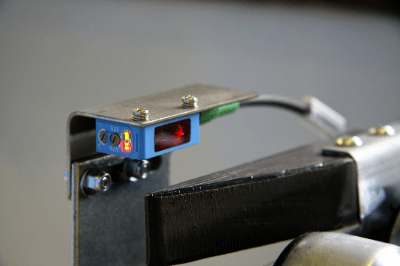What Is a Photoelectric Element?

A photoelectric element is the general term for electronic elements responsible for the conversion between light energy and electrical energy.
Broadly speaking, there are light emitting elements that convert electrical signals into optical signals and light receiving elements that convert optical signals into electrical signals. Light-emitting elements emit light when an electric current is applied, and light-emitting diodes are a typical example.
Light-emitting diodes are typical examples. Light bulbs and fluorescent lamps also emit light when an electric current is applied, but light-emitting elements are limited to those using semiconductors and do not include them. Photodetectors receive light and generate an electric current, of which solar cells are an example.
Uses of Photoelectric Elements
Photoelectric elements are used in a great many devices in fields that utilize light. In the case of light emitting elements, light-emitting diodes can be used in the light emitting parts of lighting equipment, photo interrupters and other sensors as light sources for object detection, semiconductor lasers as signal light sources in the field of optical communications, and many other examples can be given of their use.
In addition to the solar cells mentioned above, examples of photodetectors include illuminance meters, exposure meters for cameras, pickups for CDs and DVDs, image sensors for photographic equipment, and sensors that detect reflected light from objects in photo interrupters.
Principle of Photoelectric Elements
The principle of a light emitter and a light receiver are very different.
1. Luminous Element
The basic structure of a light-emitting diode as a representative light-emitting device is a PN junction, which consists of a P-type semiconductor (with the majority of holes as carriers) and an N-type semiconductor (with the majority of electrons as carriers).
When a forward voltage is applied to a light-emitting diode, electrons and holes move through the light-emitting diode chip, causing an electric current to flow. When the electrons and holes collide during the transfer, they recombine, but in this state, the energy of the electrons and holes is less than the combined energy they originally possessed.
This reduced energy is converted into light and emitted outside the semiconductor. This is the principle of luminescence.
2. Light Receiving Element
Photodetectors are based on the photoelectric effect. The photoelectric effect refers to what occurs at the PN junction of the semiconductor. Even if both ends of the photodiode are shorted, an electric field is formed at the PN junction and a potential gradient is generated within it.
When light is irradiated in this electric field, its energy generates electrons and holes, but the potential gradient causes the electrons to move immediately. The stronger the light (the greater the number of photons) will produce a greater current.
Applying a reverse bias voltage to the PN junction widens the electric field, resulting in the generation of electrons and holes in a wider area. Also, since the slope of the potential becomes stronger, the carriers move faster and a faster response can be expected.
Types of Photoelectric Elements
Semiconductor elements classified as photoelectric elements include the following:
1. Luminous Element
Light-Emitting Diode
Many light-emitting diodes with different emission wavelengths from the near-infrared to visible regions have been commercialized, and demand for blue LEDs, in particular, is growing very rapidly as they are used in lighting fixtures. On the other hand, light-emitting diodes emitting near-infrared light are used as devices for optical communications.
Semiconductor Laser
It can emit light that is stronger and more coherent than ordinary LEDs. Familiar applications include laser pointers that take advantage of its linearity, and light sources for projectors that take advantage of its high luminous flux and single wavelength.
OLED (Electro Luminescence)
It is used for thin and lightweight displays such as TVs and viewfinders for photographic equipment.
2. Light Receiving Element
Photodiode
There are various applications, such as sensors for illuminance meters and other measuring instruments that measure the intensity of light, and sensors for detecting objects with light.
Phototransistor
It is a sensor with higher sensitivity than a photodiode because it receives light in the base region of the transistor and the current generated there can be amplified and extracted. It is mainly used in the light receiving part of photo interrupters.
Image Sensors
A sensor used to create image data by projecting an image onto numerous photodiodes arranged in a flat pattern. They are used in the imaging section of cameras that take still and moving images.
Although they are very large and expensive as semiconductor devices, they have become widely used, replacing the imaging tubes and photographic films that were once used.